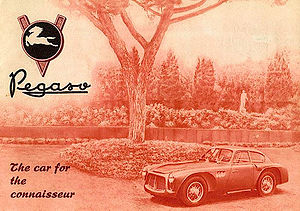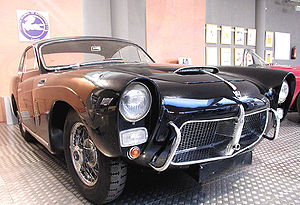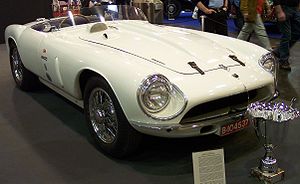
Pegaso Z-102
Encyclopedia



Sports car
A sports car is a small, usually two seat, two door automobile designed for high speed driving and maneuverability....
coupé
Coupé
A coupé or coupe is a closed car body style , the precise definition of which varies from manufacturer to manufacturer, and over time...
produced in Spain
Spain
Spain , officially the Kingdom of Spain languages]] under the European Charter for Regional or Minority Languages. In each of these, Spain's official name is as follows:;;;;;;), is a country and member state of the European Union located in southwestern Europe on the Iberian Peninsula...
between 1951 and 1958.
Background
PegasoPegaso
Pegaso was a Spanish make of trucks, omnibuses, tractors, armored vehicles, and, for a while, sports cars. The parent company, Enasa, was created in 1946 and based in the old Hispano-Suiza factory, under the direction of the renowned automotive engineer Wifredo Ricart...
was an established company noted for its trucks and motor coaches, but also produced sports cars for seven years. Pegaso chief technical manager by then was Wifredo Ricart
Wifredo Ricart
Wifredo Pelayo Ricart Medina was a Spanish engineer, designer and executive manager in the automotive industry, who spent his professional career in Spain and Italy.- The Barcelona "Happy Twenties" :...
, former design
Design
Design as a noun informally refers to a plan or convention for the construction of an object or a system while “to design” refers to making this plan...
er of the Alfa Romeo
Alfa Romeo
Alfa Romeo Automobiles S.p.A. is an Italian manufacturer of cars. Founded as A.L.F.A. on June 24, 1910, in Milan, the company has been involved in car racing since 1911, and has a reputation for building expensive sports cars...
512, and fellow rival of Enzo Ferrari
Enzo Ferrari
Enzo Anselmo Ferrari Cavaliere di Gran Croce OMRI was an Italian race car driver and entrepreneur, the founder of the Scuderia Ferrari Grand Prix motor racing team, and subsequently of the Ferrari car manufacturer...
, who at the time had also worked for Alfa Romeo
Alfa Romeo
Alfa Romeo Automobiles S.p.A. is an Italian manufacturer of cars. Founded as A.L.F.A. on June 24, 1910, in Milan, the company has been involved in car racing since 1911, and has a reputation for building expensive sports cars...
.
Design
The Z-102 employed racing-car technology in its chassis and alloy body. Everything was produced in-house at BarcelonaBarcelona
Barcelona is the second largest city in Spain after Madrid, and the capital of Catalonia, with a population of 1,621,537 within its administrative limits on a land area of...
, where the Pegaso cars factory was, with the exception of the external coachworking, either by Carrozzeria Touring
Carrozzeria Touring
Carrozzeria Touring is an automobile coachbuilder established on March 25, 1926 in Milan, Italy by Felice Bianchi Anderloni and Gaetano Ponzoni...
, Saoutchik
Saoutchik
Founded by cabinet maker Jacques Saoutchik , Saoutchik was a top-class French coachbuilding company founded in 1906. In the 1930s the company became famous for their high quality and often extravagant designs. After Jacques died in 1955, the company passed into the hands of his son Pierre...
or Serra (although early Z-102 units carry Pegaso-made bodies). A four-cam all-alloy V8 engine, dry-sump lubrication, and a 5-speed non-syncronmesh gearbox mounted with the differential as a unit were within a pressed steel chassis.
The Z-102 started life as two prototypes in 1951 as a coupe and a drophead. The coupe and convertible had dumpy steel bodies, and weight was an issue to the extent that Pegaso made the decision to revert to alloy for the coachwork. Coachbuilder Touring then 'beautified' the design, replacing the grille with a two-piece cross, lowering the car, repositioning the foglights, and simplifying various details to give it a clean profile, similar to the contemporary Aston Martin DB2
Aston Martin DB2
The Aston Martin DB2 is a sports car sold by Aston Martin from May 1950 through to April 1953. It was a major advancement over the 2-Litre Sports model it replaced, with a dual overhead cam straight-6 in place of the previously-used pushrod straight-4. The car featured a 2.6 L engine, and was...
and the Lancia Aurelia
Lancia Aurelia
The Lancia Aurelia is a car that was produced by the Italian manufacturer Lancia. Designed by Vittorio Jano, the Aurelia was launched in 1950 and production lasted until the summer of 1958....
, that was the most memorable and numerous of all Z-102 bodies.
The Z102 entered production with a 2.5 (2472cc) litre engine as used in the prototypes, though later there were variants with 2.8 (2816cc), and 3.2 (3178cc) litre DOHC desmodromic
Desmodromic valve
A desmodromic valve is a reciprocating engine valve that is positively closed by a cam and leverage system, rather than by a more conventional spring...
32-valve
Poppet valve
A poppet valve is a valve consisting of a hole, usually round or oval, and a tapered plug, usually a disk shape on the end of a shaft also called a valve stem. The shaft guides the plug portion by sliding through a valve guide...
V8 360 hp
Horsepower
Horsepower is the name of several units of measurement of power. The most common definitions equal between 735.5 and 750 watts.Horsepower was originally defined to compare the output of steam engines with the power of draft horses in continuous operation. The unit was widely adopted to measure the...
(270 kW) engines with multiple carburetors or optional supercharger. Horsepower
Horsepower
Horsepower is the name of several units of measurement of power. The most common definitions equal between 735.5 and 750 watts.Horsepower was originally defined to compare the output of steam engines with the power of draft horses in continuous operation. The unit was widely adopted to measure the...
ranged from 175 to 360, and, transferred through a five-speed gearbox and gear-driven camshaft, the fastest could reach 155 miles per hour (249.4 km/h), exceeding Ferrari autos, thus making it the world's fastest production car at the time. The base model had an 120 mph (192 km/h) top speed.
The main beams of the car's frame had large lightening holes, and the wheel wells under the body were used as stressed members.
This rear-wheel-drive car had its transmission in the rear, connected to the differential (making it a transaxle). But it was unusually located behind the differential within a reverse A-frame whose apex was at the rear of the chassis. A fuel tank was situated on each side of the transmission.
The rear suspension was of the De Dion
De Dion tube
A de Dion tube is an automobile suspension technology. It is a sophisticated form of non-independent suspension and is a considerable improvement over the alternative swing axle and Hotchkiss drive types. A de Dion suspension uses universal joints at both the wheel hubs and differential, and uses a...
type, with the unusual feature that, to restrain the tube from side-to-side movement, its tube had a small wheel at its midpoint that rolled in a vertical channel on the front of the differential (which in a De Dion system is bolted to the chassis) instead of using a Watts linkage or a Panhard rod
Panhard rod
A Panhard rod is a component of a car suspension system that provides lateral location of the axle...
.
However, the cars were heavy and brutish to drive and competition success was virtually nonexistent. Because the cars were built on a cost-no-object basis, this caused financial difficulty in the company. A simplified and cheaper version, the Z-103 with 3.9, 4.5 and 4.7 litre engines, was put into production, but to no avail, and the Z-102 was discontinued after 1958. Just 86 cars were produced, and out of these, only a handful of cabriolets were built.
Racing and elegance contests
The Pegasos raced in several competitions, but with no real success. In the 1953 Le Mans24 Hours of Le Mans
The 24 Hours of Le Mans is the world's oldest sports car race in endurance racing, held annually since near the town of Le Mans, France. Commonly known as the Grand Prix of Endurance and Efficiency, race teams have to balance speed against the cars' ability to run for 24 hours without sustaining...
trials, driver Jose Jover was seriously injured after crashing at more than 200 km/h. They competed also in the 1954 Carrera Panamericana
Carrera Panamericana
The Carrera Panamericana was a border-to-border sports car racing event on open roads in Mexico similar to the Mille Miglia and Targa Florio in Italy. Running for five consecutive years from 1950 to 1954, it was widely held by contemporaries to be the most dangerous race of any type in the world...
, driven by Joaquin Palacio, with increasingly promising results in the first stages, but again an accident prevented an excellent final position.
Furthermore, on September 25, 1953, in Jabbeke
Jabbeke
Jabbeke is a municipality located in the Belgian province of West Flanders. The municipality comprises the towns of Jabbeke proper, Snellegem, Stalhille, Varsenare and Zerkegem. On 1 January 2006 the municipality had 13,572 inhabitants...
(Belgium), a Z-102 Touring BS/2.8 (the old Barchetta used at Le Mans, 2.8 litre single supercharger), driven by Celso Fernández, broke four official R.A.C.B. (Royal Automobile Club de Belgique) worldwide records (fastest of them, 243.079 Km/h (= 151.042 mph) average in the flying-start kilometer), previously owned by a Jaguar XK120
Jaguar XK120
The Jaguar XK120 is a sports car which was manufactured by Jaguar between 1948 and 1954. It was Jaguar's first sports car since the SS 100, which ceased production in 1940.-History:...
. The original Z-102 BSS/2.5 Bisiluro Especial Competición (2.5 litre twin supercharged) meant to take on the records couldn't be used because of a blown engine.
Pegasos achieved much better results in several Concours d'Elegance
Concours d'Elegance
A Concours d'Elegance dates back to 17th Century French aristocracy, who paraded horse-drawn carriages in the parks of Paris during Summer weekends and holidays...
contests. A Pegaso Z-102 coupé by Saoutchick, owned by Baron Thyssen-Bornemisza
Baron Hans Heinrich Thyssen-Bornemisza
Hans Henrik Ágost Gábor Tasso Freiherr Thyssen-Bornemisza de Kászon et Impérfalva , a noted industrialist and art collector, was a Dutch-born Swiss citizen with a Hungarian title, a legal resident of Monaco for tax purposes, with a declared second residency in the United Kingdom, but in actuality...
, was in this respect the epitome of coachwork sophistication, as it had seats upholstered with leopard skin and controls in gold, and in such a finish it won the 1953 Enghien-les-Bains
Enghien-les-Bains
Enghien-les-Bains is a commune in the northern suburbs of Paris, France. It is located from the centre of Paris, in the département of Val-d'Oise....
(France) Grand Prix d'Elegance.
Technical data
| Pegaso | Z-102 |
|---|---|
| Produced: | 1953–1958 |
| Engine: | front-mounted, longitudinal V8 engine with alloy block and cylinder head |
| Bore x Stroke: | 80 mm x 70 mm |
| Displacement: | 2816 cc |
| Max power @ rpm: | 170 CV (at least) @ 6300 rpm |
| Max torque @ rpm: | 22 kg·m @ 3600 rpm |
| Compression ratio: | 8,8 : 1 |
| Fuel feed: | 4 Weber 36 DCF3 carburetors |
| Valvetrain: | DOHC |
| Cooling: | water |
| Gearbox: | 5 speed manual rear wheel drive, axle ratio: 4,18:1 to 5,2:1 |
| Front suspension: | Multi-link suspension, torsion bar |
| Rear suspension: | De Dion axle |
| Brakes: | drum brakes |
| Steering: | rack and pinion |
| Body structure: | aluminium/steel on multitubular frame |
| Weight: | 990 kg |
| Track front/rear: | 1320mm / 1290 mm |
| Wheelbase: | 2340 mm |
| Length: | 4100 mm |
| Top speed: | 225 km/h |
| Acceleration (0–100 km/h): | 8,5 seconds |
| Fuel consumption (estimate): | 13,2 to 14,5 liters/100 km |

